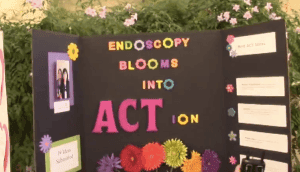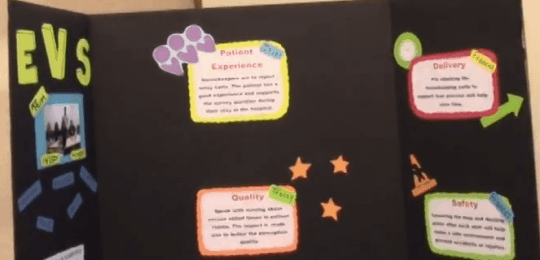Thanks to my friend (and future co-author) Mike Stoecklein for sharing this video (and a blog post) about his Healthcare Value Network visit to Scottsdale Lincoln Health Network (now called HonorHealth).
 The video shows many employees from many different departments at what they call an “ACT Fair” – an improvement fair where different departments highlight how they “act” to improve. Kaizen isn't just about identifying opportunities or making suggestions… it's about testing and implementing improvements.
The video shows many employees from many different departments at what they call an “ACT Fair” – an improvement fair where different departments highlight how they “act” to improve. Kaizen isn't just about identifying opportunities or making suggestions… it's about testing and implementing improvements.
It's great to see, in that first department, that they've implemented such a high percentage of their ideas (52 out of 72). That's a sign of a healthy improvement program. A good benchmark (from Toyota and healthcare organizations like Franciscan St. Francis Health is to implement near 90% of your ideas, even if that means changing the idea along the way).
The ED improvement of having cell phone chargers available for patients — I've had a client of mine come up with the same idea in another hospital ED and they asked volunteers to bring in old chargers from home.
Sure, it might be better for the team to reduce E.D. waiting times so that phones don't go dead… but making chargers available is a thoughtful short-term countermeasure perhaps.
Imagine how powerful it would be to have a widely available database of improvement ideas that hospitals could use to share and learn. I'm sure each ED has the creativity to come up with this idea based on their own customer feedback, but I wonder how it would help to share ideas… we don't want to shortcut people's learning and sharing ideas shouldn't be a replacement for thinking, but maybe there's a happy balance?
Scottsdale Lincoln seems to be doing a great job of not just asking for cost savings. The improvements shown here talk about safety, quality, patient satisfaction… making work easier and less frustrating.

The improvements shown from EVS were:
- Patient Experience: reporting noisy carts that patients would otherwise complain about
- Quality: Speaking with nursing about excess soiled linens in patient bathrooms, creates perception that it's not dirty
- Delivery: Pre-stocking the housekeeping carts to help save time
- Safety: Lowering the dusting and mopping poles at the end of shift to help reduce injuries
- Financials (not pictured): Replacing measuring buckets to prevent over use of chemicals
- People (not pictured): Sign in sheets added for daily huddles
That's the power of Kaizen. If we get people participating in Kaizen, cost savings will follow… but as the end result of the process or because we occasionally stumble into something big (like this simple Kaizen from a hospital that led to over $2.5 million a year in additional revenue).
My only question for Scottsdale Lincoln Health would be if they have a formal way of documenting improvements, in a simple template or in software? Documenting improvements is a critically important step of the Kaizen process that Joe and I lay out in our books (that process being find, discuss, implement, document, and share).
Documenting ideas:
- Prompts reflection on what we learned and what the benefits of the Kaizen are
- Allows us to recognize and celebrate the improvements
- Helps us share them with other departments
I hope you enjoy the video as I did. I'll be releasing some videos from my recent visit with Joe Swartz and Franciscan… hopefully soon. These video are all very powerful. Wouldn't it be great to have a culture of continuous improvement?
I leave for Japan on Wednesday. I'll be tweeting and blogging along the way…
Please scroll down (or click) to post a comment. Connect with me on LinkedIn.
Let’s build a culture of continuous improvement and psychological safety—together. If you're a leader aiming for lasting change (not just more projects), I help organizations:
- Engage people at all levels in sustainable improvement
- Shift from fear of mistakes to learning from them
- Apply Lean thinking in practical, people-centered ways
Interested in coaching or a keynote talk? Let’s talk.
Join me for a Lean Healthcare Accelerator Trip to Japan! Learn More










[…] Come back Friday for some video clips from an Arizona hospital that also has many people involved i…. […]
Comments are closed.